Which telescope for astrophotography?
Lens telescope, Newtonian, Schmidt-Cassegrain or astrograph? Four things are important – along with what you want to photograph.
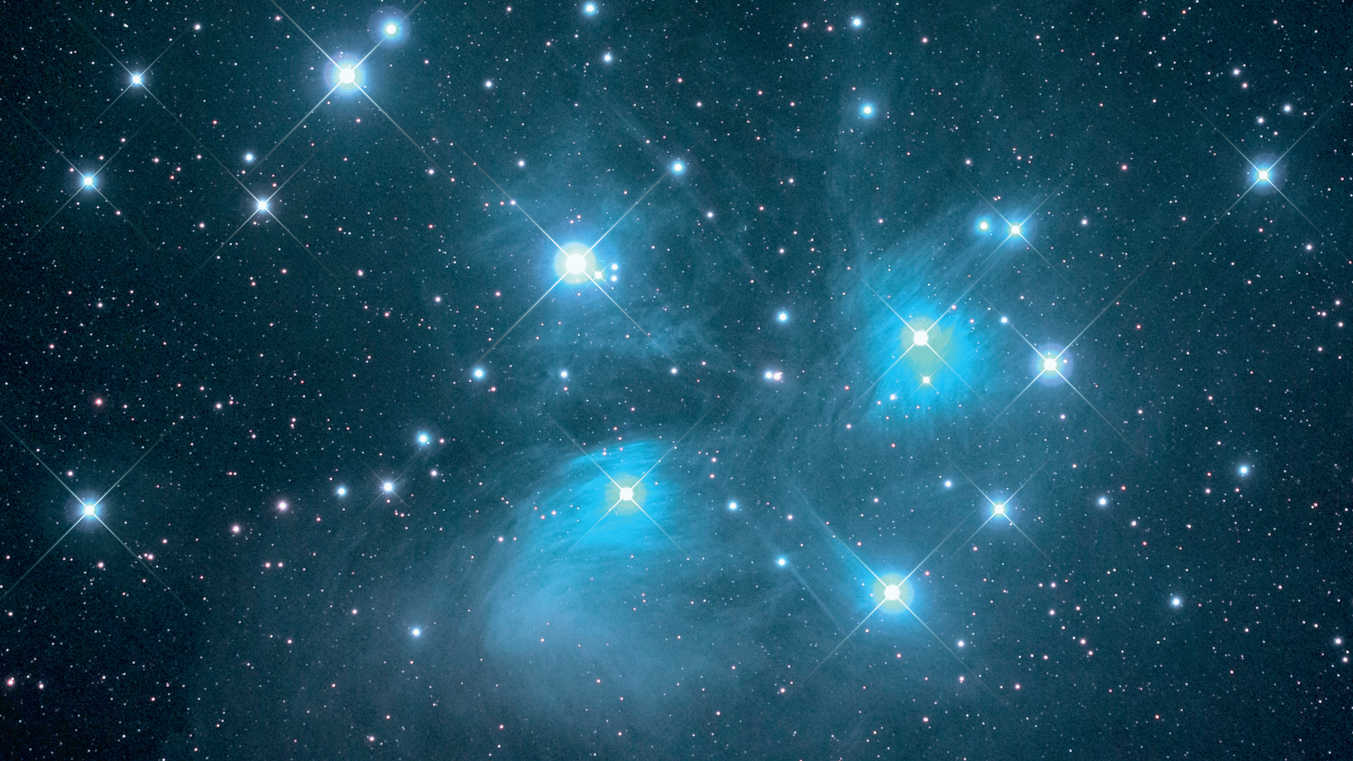 The aim of astrophotography is to achieve needle-sharp stars right to the edges of the image.
For this image of the Pleiades (Messier 45), a refractor with a 530-mm focal length
(f/5) was used together with a full-frame DSLR. The picture consists of 12 images, each with an exposure time of 300 seconds (at ISO 1600), giving a total exposure time of 60 minutes.
The aim of astrophotography is to achieve needle-sharp stars right to the edges of the image.
For this image of the Pleiades (Messier 45), a refractor with a 530-mm focal length
(f/5) was used together with a full-frame DSLR. The picture consists of 12 images, each with an exposure time of 300 seconds (at ISO 1600), giving a total exposure time of 60 minutes. At first glance, the variety of telescopes on the market seems confusing: different designs, different focal ratios, telescopes that are optimized for photography - beginners will find the selection difficult. When choosing a telescope for astrophotography, four things are important: the focal length of the telescope, its design, the focal ratio and the size of the image field.
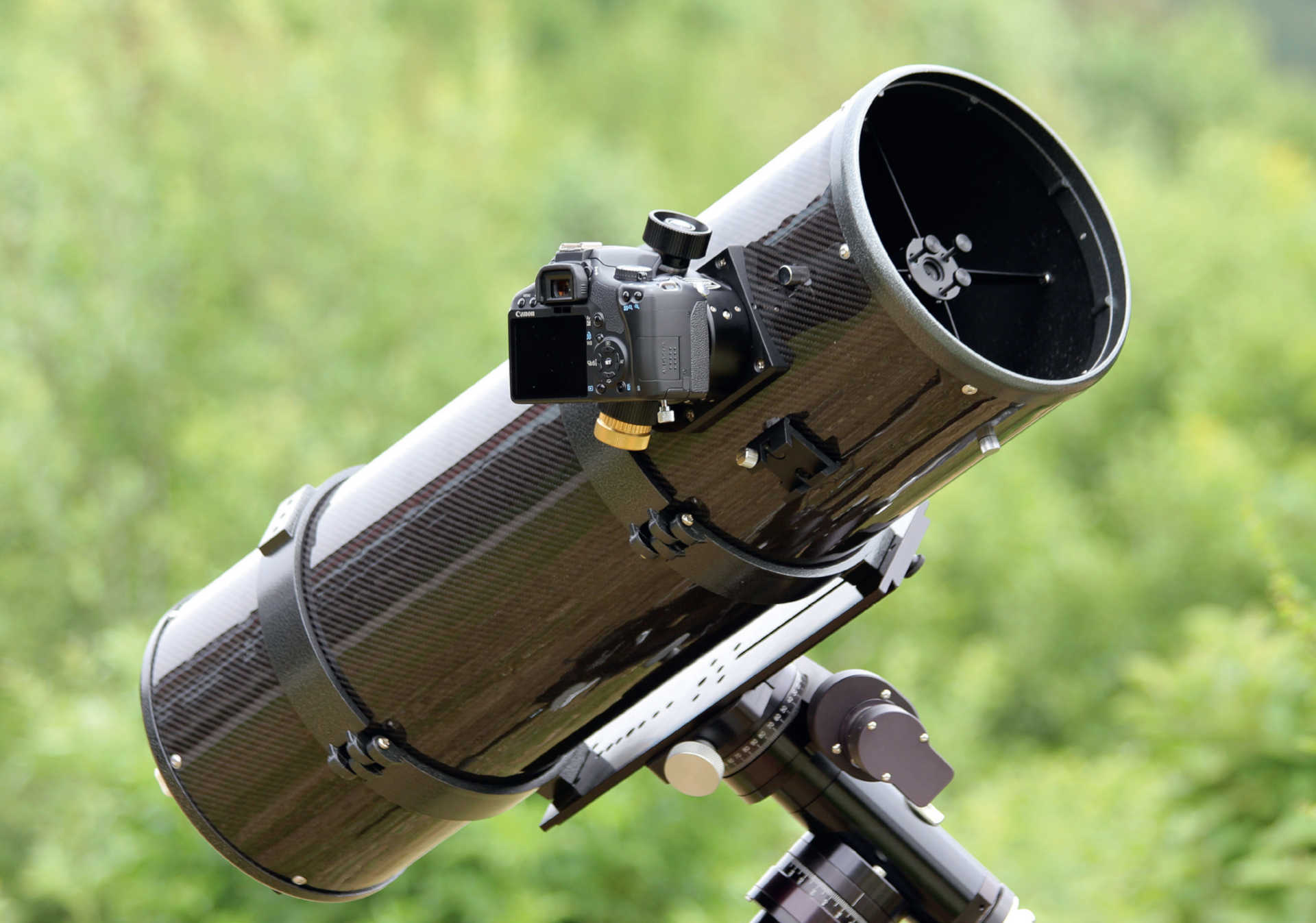 Many amateur telescopes can be connected to a DSLR with little effort. Here we are using a low-cost camera
with an APS-C sensor together with a Newtonian telescope.
Many amateur telescopes can be connected to a DSLR with little effort. Here we are using a low-cost camera
with an APS-C sensor together with a Newtonian telescope. Size of the image field
Depending on the camera you are planning to use for astrophotography, the telescope must illuminate the image field without distortion, so that, even in the corners of your picture, stars are needle-sharp and there are no unattractive specks of light. In addition, the telescope should provide an (almost) evenly illuminated image over the entire image field, so that details and stars at the edge of the image are not swallowed by shading or vignetting.
If you are using a digital SLR camera with APS-C sensor to get started in astrophotography, the chip will measure around 22.3 mm × 15 mm and have a diagonal of around 28 mm; most amateur telescopes can illuminate such an image field. If you want to use a full-frame 24 mm × 36 mm chip, you will need a telescope that can illuminate an image field of at least 43 mm error-free – not all telescopes can do this these days. Unfortunately, this information is usually missing from product descriptions.
Focal ratio
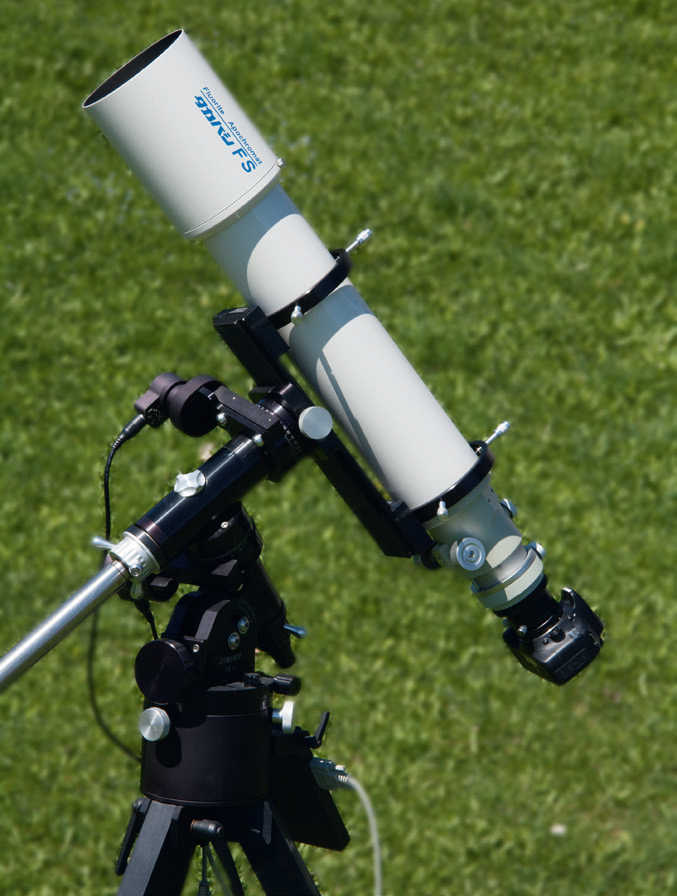 Classical lens telescopes are well suited for astrophotography. The orientation to the astronomical object and its image on the chip can be easily controlled with the Live View function.
Classical lens telescopes are well suited for astrophotography. The orientation to the astronomical object and its image on the chip can be easily controlled with the Live View function.
The light-gathering capability of photographic lenses is usually indicated by the aperture value. In the case of telescopes, the following applies: the smaller the number, the more light the telescope can gather and the shorter the exposure times that can be selected. The focal ratio is the relationship between the aperture and focal length of the telescope. With a 100-mm aperture and a 900-mm focal length, it is therefore f/9.
To put it simply, mirror telescopes (reflectors) generally have an focal ratio of between f/5 and f/7, lens telescopes (refractors) usually between f/7 and f/9, and Schmidt-Cassegrain telescopes around f/10. Special astrographs, i.e. telescopes that are optimised for astrophotography, can achieve focal ratios of between f/3 and f/5 with correspondingly short focal lengths. With such short focal length telescopes with small f-numbers, large celestial objects can be captured with short exposure times (see box).
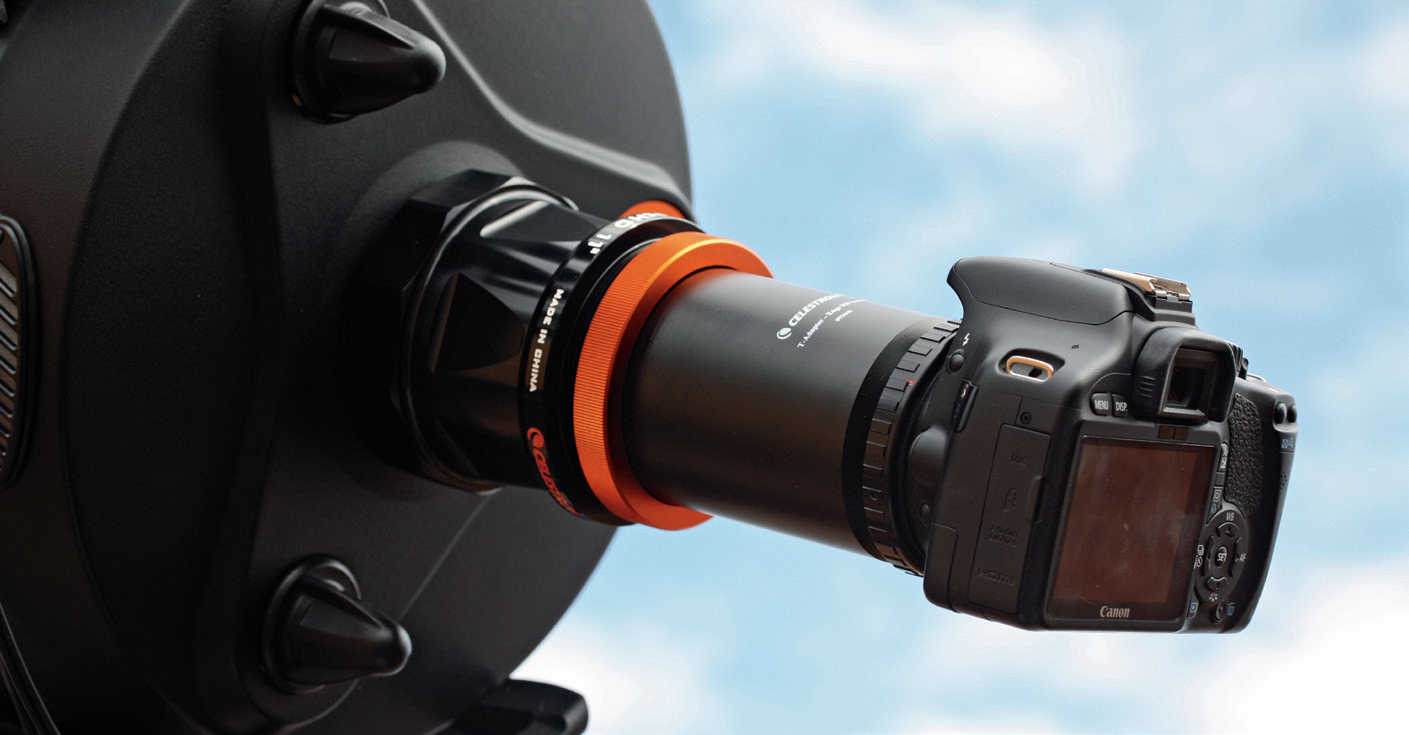 Schmidt-Cassegrain mirror telescopes collect a lot of light with their large apertures. Camera adapters offered by telescope manufacturers ensure that the camera is positioned in the optimal location behind the optics.
Schmidt-Cassegrain mirror telescopes collect a lot of light with their large apertures. Camera adapters offered by telescope manufacturers ensure that the camera is positioned in the optimal location behind the optics. In detail
Focal ratio and exposure time
The exposure time is directly related to the focal ratio of the optics used. The smaller the focal ratio, the shorter the exposure time. The table shows the relative exposure time factors required for the same image result.
focal ratio)
focal ratio)
many refractors)
focal ratio)
Design
Reflectors and refractors (or mirror and lens telescopes) are fundamentally all suitable for astrophotography. Lens telescopes are considered useful for good and high-contrast images of fine stars, while mirror telescopes, with their larger apertures and longer focal lengths, usually allow higher magnifications and are therefore particularly well suited for imaging smaller celestial objects.
Mirror or lens telescopes, in particular Schmidt-Cassegrain telescopes (SCT), usually offer even larger apertures and focal lengths, and can therefore offer even greater levels of magnification and so reproduce objects in greater detail. Some Schmidt-Cassegrain telescopes are interesting because they offer the possibility to position the camera at the focus point of the primary mirror and thus make use of the resulting focal ratio of around f/2. Very detailed deep-sky images can be created with short exposure times.
Focal length
The focal length of the telescope, together with the focal ratio, determine the size and magnification of the section of the sky that is displayed. Long focal lengths offer smaller sky segments with greater magnification, while short focal lengths show a larger section with smaller magnification.
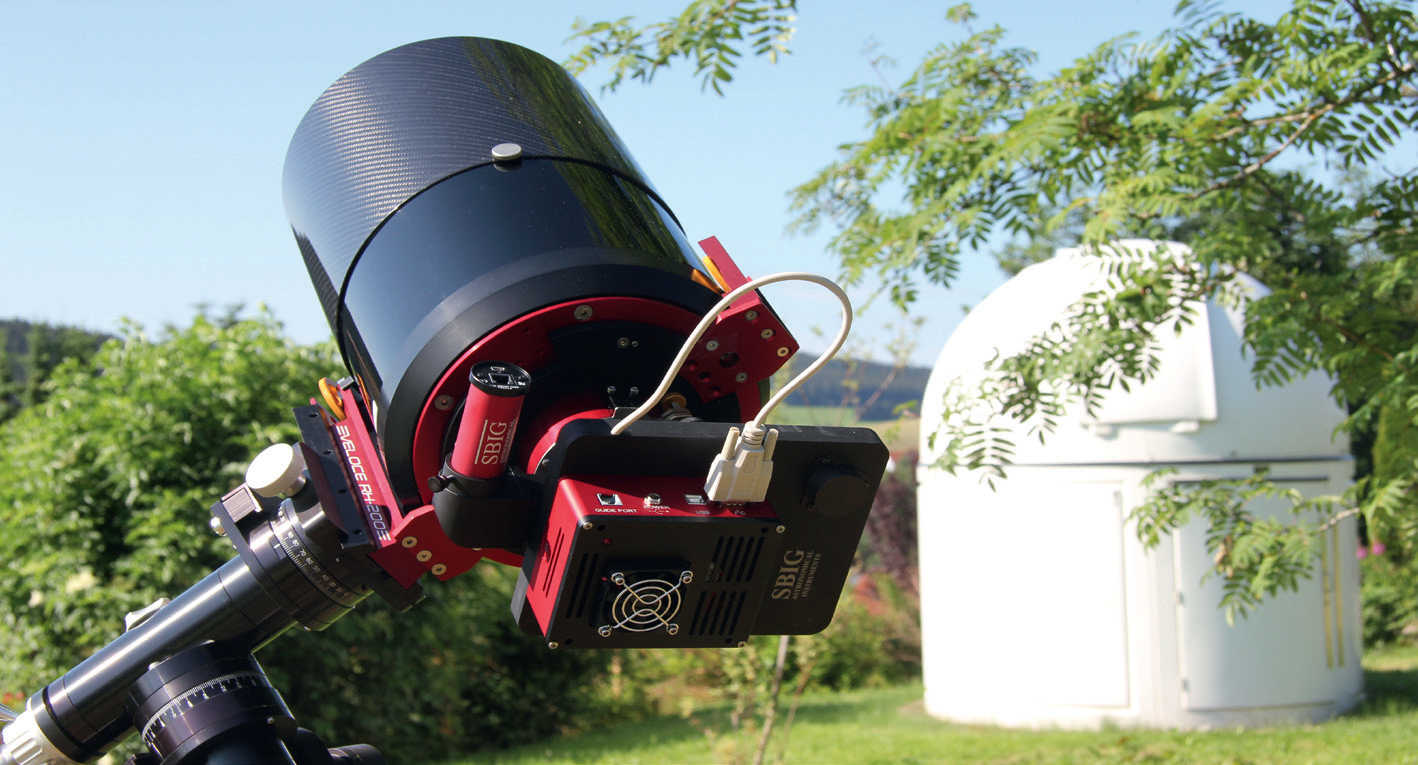 Astrographs are telescopes optimised for astrophotography, which often have high light gathering capability to allow short exposure times. The astrograph shown here has a focal length of just 600 mm at an aperture of 200 mm and thus has an focal ratio of f/3 (which is used here with a cooled Astro CCD camera).
Astrographs are telescopes optimised for astrophotography, which often have high light gathering capability to allow short exposure times. The astrograph shown here has a focal length of just 600 mm at an aperture of 200 mm and thus has an focal ratio of f/3 (which is used here with a cooled Astro CCD camera).The bottom line
Lens telescopes with focal lengths of between 500 mm and 1000 mm are well-proven for beginners interested in the photography of clusters such as h and χ Persei (NGC 869 and NGC 884), large galaxies such as the Andromeda galaxy (M 31) or large nebulae such as the Orion Nebula (M 42) or the Pleiades (M 45).
If you want to photograph fainter nebulae, mirror telescopes with a focal ratio of f/5 help to capture the structures with exposure times that are not excessive. However, if the Moon or planets are to be the first objects of your astrophotography adventures, then SC telescopes with focal lengths of over 1,500 mm are a good choice.
Author: Ullrich Dittler / Licence: Oculum-Verlag GmbH
